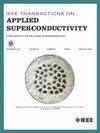Influence of Coil Structure and Operating Frequency on Performance of Superconducting Wireless Power Transfer
IF 1.7
3区 物理与天体物理
Q3 ENGINEERING, ELECTRICAL & ELECTRONIC
引用次数: 0
Abstract
High-temperature superconducting (HTS) coil magnets possess extremely high quality factors, therefore having unique advantages when applied to wireless power transfer (WPT) systems especially under low-frequency conditions. The dependence of peak output power and transfer efficiency of an HTS WPT system on the operating frequency varies with the design of the coils because the structure of the coils significantly affects the resonant frequency and ac loss of the HTS WPT system. In this work, a high-power HTS WPT system, including the transfer characteristics under different coil structures, current-carrying conditions, and operating frequencies, has been investigated based on the finite-element simulation to find the optimized operating frequency band and coil structure. It has been found that the change of the inner radius and turn gap in both the solenoid and pancake coils induces a predictable transition frequency change. As the gap is varied, the transfer efficiency remains relatively constant for both coil types. However, for solenoids, reducing the gap value enhances the transferred power, whereas for pancake coils, increasing the gap value augments the transferred power. A transfer efficiency as high as 98.86% or more can be achieved under the optimal conditions.线圈结构和工作频率对超导无线输电性能的影响
高温超导(HTS)线圈磁体具有极高的质量因数,因此在应用于无线电力传输(WPT)系统时具有独特的优势,特别是在低频条件下。由于线圈的结构对高温超导WPT系统的谐振频率和交流损耗有显著影响,因此,高温超导WPT系统的峰值输出功率和传输效率对工作频率的依赖关系随线圈设计的不同而不同。本文基于有限元仿真研究了大功率高温超导WPT系统在不同线圈结构、载流条件和工作频率下的传输特性,找到了最优的工作频带和线圈结构。研究发现,电磁线圈和烙饼线圈的内半径和匝隙的变化都会引起可预测的过渡频率变化。随着间隙的变化,两种线圈类型的传递效率保持相对恒定。然而,对于螺线管,减小间隙值可以增强传输功率,而对于煎饼线圈,增大间隙值可以增强传输功率。在最优条件下,传热效率可达98.86%以上。
本文章由计算机程序翻译,如有差异,请以英文原文为准。
求助全文
约1分钟内获得全文
求助全文
来源期刊

IEEE Transactions on Applied Superconductivity
工程技术-工程:电子与电气
CiteScore
3.50
自引率
33.30%
发文量
650
审稿时长
2.3 months
期刊介绍:
IEEE Transactions on Applied Superconductivity (TAS) contains articles on the applications of superconductivity and other relevant technology. Electronic applications include analog and digital circuits employing thin films and active devices such as Josephson junctions. Large scale applications include magnets for power applications such as motors and generators, for magnetic resonance, for accelerators, and cable applications such as power transmission.
 求助内容:
求助内容: 应助结果提醒方式:
应助结果提醒方式:


